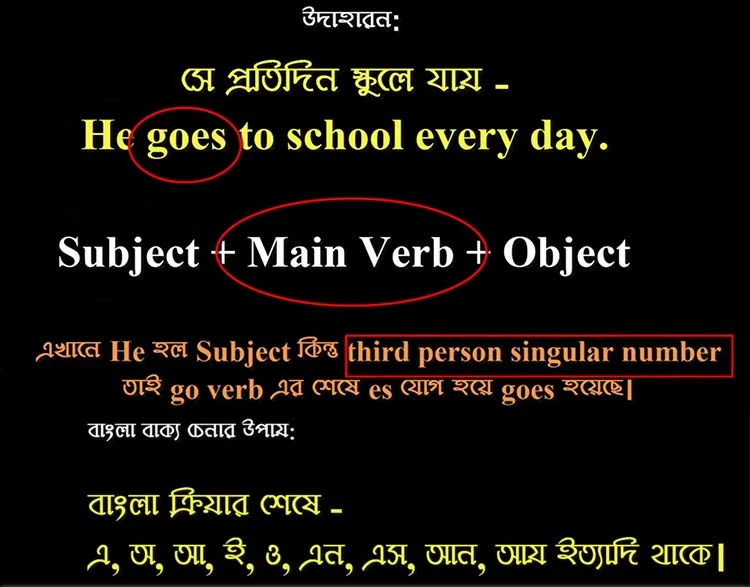Present indefinite tense কাকে বলে উদাহরন সহ লিখ
১. Present indefinite tense: বর্তমান কালে কোনো কাজ সাধারণভাবে হয় বা হয়ে থাকেএরূপ বোঝালে verb-এর present indefinite tense হয়। চিরন্তন সত্য, নিকট ভবিষ্যৎ, অভ্যাস,প্রকৃতি বোঝাতেও present indefinite tense হয়।অর্থাৎ বর্তমান কালে কোন কাজ করা হয়ে থাকে, অথবা অভ্যাসগতভাবে করা হয়, অথবা চির সত্য কোন কাজ বোঝালে তাকে Present Indefinite Tense ব্যবহার করা হয়।
গঠন প্রণালি: Subject-এর পর মূল verb-এর present form ব্যবহূত হয়। তবে subject (কর্তা) third person singular number হলে মূল verb-এর শেষে s বা es যোগ করতে হয়।
বাংলায় চেনার উপায়: Verb এর শেষে অ, আ, এ, ই, এন, ও,এস,আয়,আন থাকবে।
যেমন Example:
o I go to School - আমি স্কুলে যাই।
o He goes to school - সে স্কুলে যায়।
o They play cricket - তারা ক্রিকেট খেলে।
Structure of the sentence: Base/root form of the verb is used as the main
verb.
Positive Sentence:
Subject + main verb + complement
Note: In a sentence, if the subject is a third person singular number
(he, she, it, or a singular noun), then ‘s’, ‘es’, ‘ies’ is added with the main
verb in the sentence. But, if the subject is plural, there will be no addition
of ‘s’, ‘es’, or ‘ies’.
Example:
o I go to the market. (using the
root form ‘go’)
o He goes to the market. (root
form of the verb is ‘go’ but ‘he’ is a third person singular number that’s why
an extra ‘es’ is added with the verb)
o Hasina wants a cup of tea.
(Hasina is third person singular number)
o The boys play cricket. (‘the
boys’ = a third person plural number, that’s why there is no ‘s’ with the verb)
Negative Sentence:
Subject + Do not/Does not + main verb + object
Note: If the subject is ‘he/she/it or a singular noun’ then ‘Does not’
will be used to make it negative. If the subject of a sentence is
‘I/you/we/they’ or a plural noun, then ‘Do not’ will be used to make it
negative.
Example:
o Positive: I eat rice.
Negative: I do not eat rice.
o Positive: He goes to School.
Negative: He does not go to School.
o Positive: He walks in the evening.
Negative: He does not walk in the evening.
o Positive: They like to dance.
Negative: They do not like to dance.
Question Sentence:
Do/ Does + Subject + Main verb + Object + Note of interrogation (?)
Note: If the sentence starts with the subject ‘he/she/it or a singular
noun’ then ‘Does’ is used to make it Interrogative. If the sentence starts with
the subject ‘I/we/you/they or a plural noun’ then ‘Do’ is used to make it
Interrogative.
Example:
o Positive: He sings a song.
Interrogative: Does he sing a song?
o Positive: She likes to talk to
you.
Interrogative: Does she like to talk to you?
o Positive: We try to do the
assignment.
Interrogative: Do we try to do the assignment?
o Positive: They love you.
Interrogative: Do they love you?
Using ‘Be verb’ (am/is/are):
Subject + be verb (am/is/are) + object
Note: ‘am’ is used with the subject ‘I’. ‘is’ is used with the subject
‘he/she/it or the singular form of nouns. ‘are’ is used with the ‘we/you/they
or the plural form of nouns.
Example:
o I am a musician.
o It is my pen
o You are a fraud.
Negative sentence:
Subject + am not/is not/are not + object
Example:
o Positive: I am a good boy.
Negative: I am not a good boy.
o Positive: It is her book.
Negative: It is not her book.
o Positive: You are my friend.
Negative: You are not my friend.
Interrogative:
Am/is/are + subject + object + Note of Interrogation (?)
Example:
o Positive: I am an intelligent
boy.
Interrogative: Am I an intelligent boy?
o Positive: He is angry.
Interrogative: Is he angry?
o Positive: They are my friends.
Interrogative: Are they my friends?





No comments